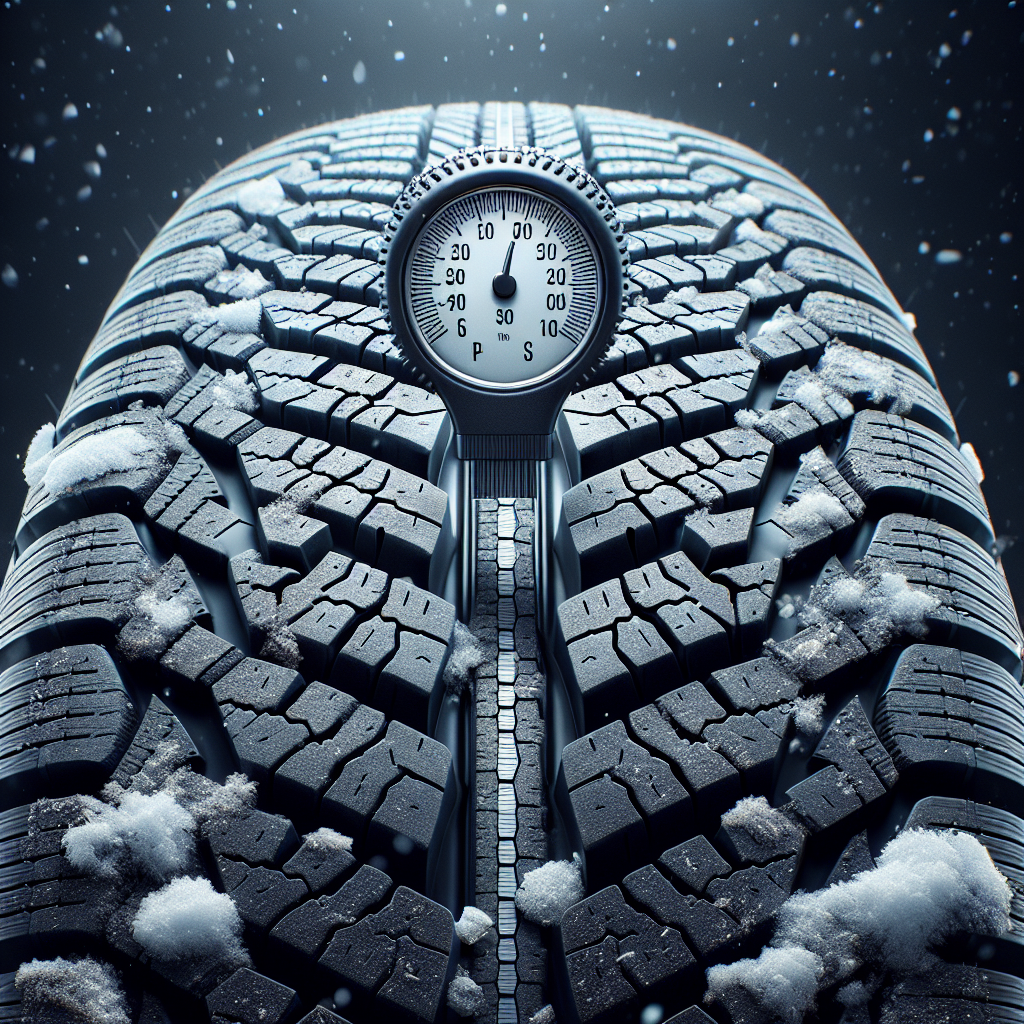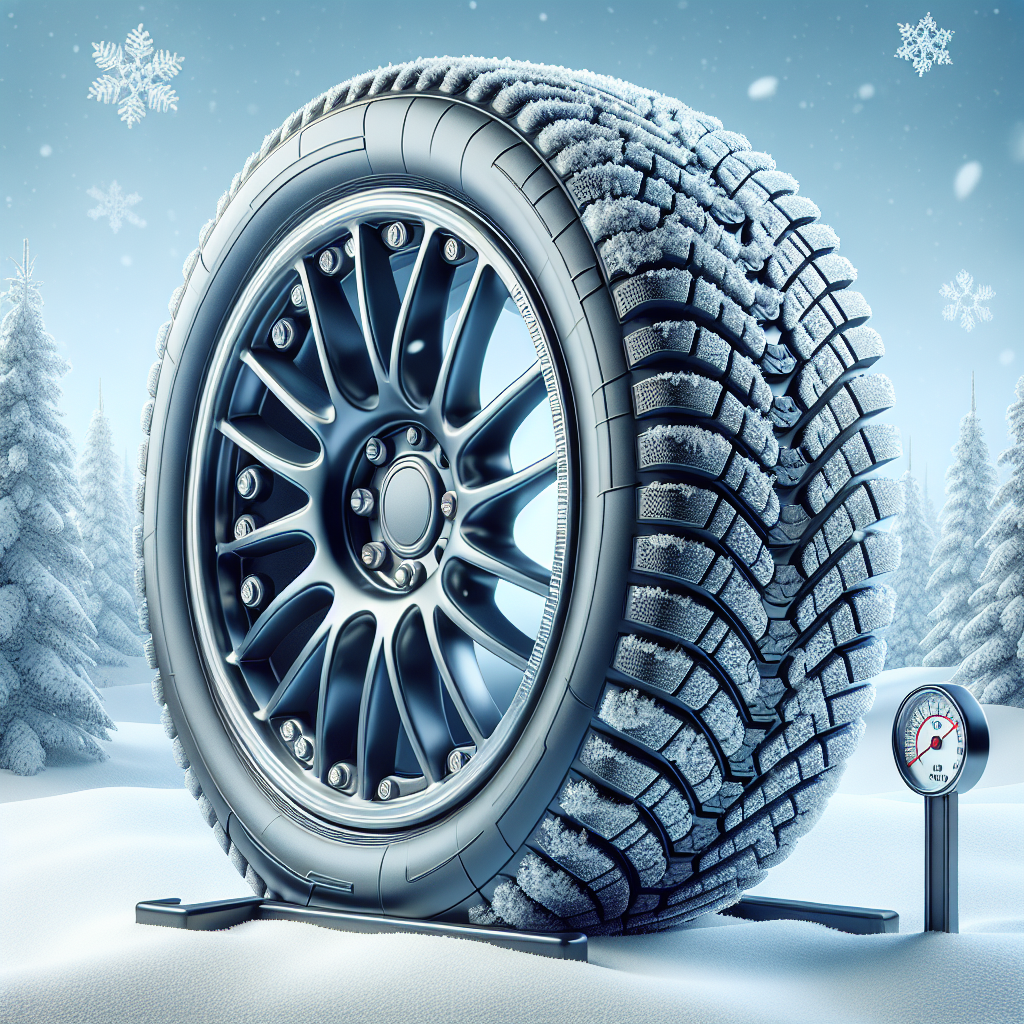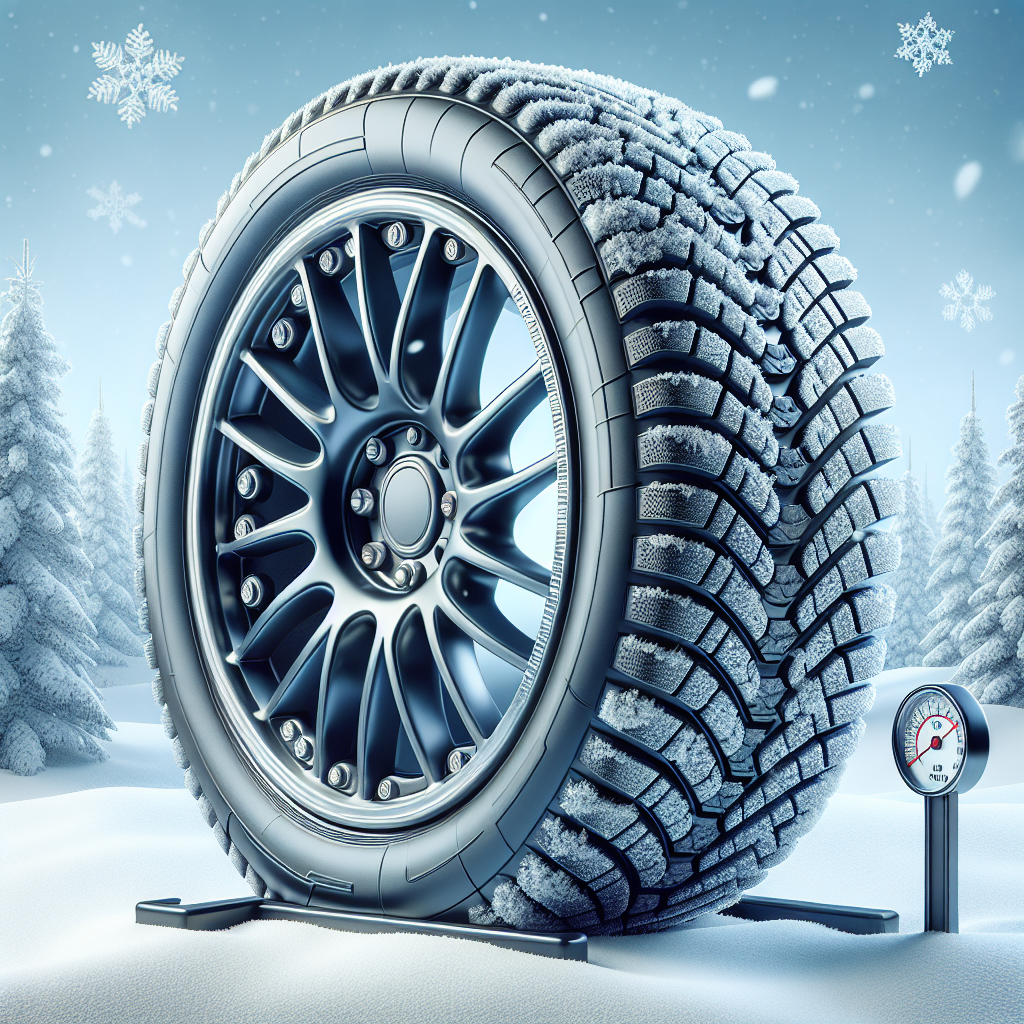Are you wondering how often you should check the tread depth of your winter tires? With the arrival of colder weather, it is important to ensure that your tires are in optimal condition for safe driving on snow and icy roads. Regularly inspecting the tread depth of your winter tires is crucial to maintain their effectiveness and ensure your safety on winter roads. In this article, we will explore the recommended frequency for checking your winter tire treads and the signs that indicate it might be time for a replacement.

The Importance of Inspecting Tread Depth
When it comes to winter tires, one of the most crucial factors to consider is the tread depth. The tread depth plays a significant role in providing traction and grip on slippery surfaces, ensuring a safe and comfortable driving experience. Understanding the importance of inspecting tread depth is essential for maintaining the performance and effectiveness of your winter tires.
Understanding the Role of Tread Depth
The tread depth refers to the vertical measurement between the top of the tread rubber to the deepest groove. This measurement is crucial because it determines the tire’s ability to channel water, snow, and slush away from the tire surface, providing better traction on wet and winter roads. It is important to note that most new winter tires come with tread depths of around 9/32 to 11/32 inches, which is considered optimal for winter driving conditions.
Effects of Improper Tread Depth
Driving with improper tread depth can have several negative effects on your winter tires’ performance and your overall safety. Insufficient tread depth can significantly reduce the tire’s ability to grip the road, leading to decreased traction and increased stopping distances. This lack of traction can become particularly dangerous on wet, icy, or snowy roads, increasing the risk of accidents. Additionally, inadequate tread depth can increase the likelihood of hydroplaning, where the tires lose contact with the road surface due to the inability to displace water effectively.
Benefits of Regular Tread Depth Inspections
Regularly inspecting the tread depth of your winter tires offers numerous benefits. It allows you to detect and address any issues with tread wear before they become a significant concern. By catching any signs of uneven wear or worn-out tread early on, you can take appropriate measures such as tire rotations or replacements to ensure optimal performance and safety. Moreover, keeping a close eye on tread depth can help you track your tire’s overall condition and lifespan, allowing you to plan for the purchase of new winter tires ahead of time.

Factors Affecting Tread Wear
Several factors can influence the wear and tear of your winter tire’s tread. By understanding these factors, you can better assess how often you should inspect the tread depth and make necessary adjustments accordingly.
Type of Winter Tire
The type of winter tire you choose can have a significant impact on tread wear. Different tire models are designed with varying tread compounds and patterns, each suited for specific road conditions. For example, studded winter tires tend to wear down quicker on dry pavement compared to studless options. Be sure to consider the characteristics of your winter tires when determining the frequency of tread depth inspections.
Road Conditions
The conditions in which you regularly drive play a crucial role in determining how quickly your winter tires wear down. Frequent exposure to rough, icy, or snowy roads can accelerate tread wear compared to driving primarily on well-maintained, dry pavement. If you frequently encounter challenging driving conditions, it may be necessary to inspect your tread depth more often to ensure optimum traction and performance.
Driving Habits
Your driving habits, including speed, acceleration, and braking patterns, can also impact tread wear. Aggressive driving, such as rapidly accelerating or braking suddenly, can wear down the tread more quickly. Habits such as cornering sharply or frequently driving on uneven surfaces can also contribute to accelerated tread wear.
Tire Maintenance
Proper tire maintenance is crucial for maximizing the lifespan and performance of your winter tires. Regularly checking and maintaining proper tire pressure, rotating your tires as recommended by the manufacturer, and ensuring proper wheel alignment and balancing can help promote even tread wear. Neglecting these maintenance tasks can result in uneven tread wear, reducing the tire’s overall effectiveness.
Recommended Inspection Frequency
Determining how often to inspect the tread depth of your winter tires depends on various factors, including manufacturer’s guidelines, general recommendations, and personal considerations.
Manufacturer’s Guidelines
First and foremost, refer to the manufacturer’s guidelines for your specific winter tire model. Manufacturers often provide recommendations for tread depth inspections, taking into account the tire’s design and intended use. These guidelines are usually outlined in the tire’s user manual or available on the manufacturer’s website. Adhering to these recommendations is essential for maintaining tire performance and ensuring your safety.
General Recommendations
In addition to manufacturer guidelines, there are some general recommendations for tread depth inspections that can serve as a starting point. It is typically recommended to inspect the tread depth of your winter tires at least once a month, especially during the winter season when driving conditions can be challenging. Additionally, it is advisable to inspect the tread before embarking on long trips or after driving in severe weather conditions.
Factors to Consider
Apart from manufacturer guidelines and general recommendations, consider the factors discussed earlier that can influence tread wear. If you frequently drive in extreme winter conditions or have aggressive driving habits, more frequent inspections may be necessary. Conversely, if you primarily drive on well-maintained roads and practice cautious driving habits, you may be able to inspect tread depth less frequently.
Tread Depth Gauges
To measure tread depth accurately, consider investing in a tread depth gauge. These simple tools are readily available at auto parts stores and are relatively inexpensive. A tread depth gauge allows you to measure the precise depth of the tread grooves, enabling you to determine whether it has reached the recommended minimum tread depth for safe driving. It is recommended to measure tread depth in multiple locations across the tire to ensure an accurate assessment.

How to Measure Tread Depth
Measuring the tread depth of your winter tires is a straightforward process. By following proper techniques, you can obtain accurate measurements and make informed decisions regarding your tires’ condition.
Using a Tread Depth Gauge
To measure tread depth using a gauge, insert the probe into the tire’s grooves until it reaches the bottom. Ensure the probe is perpendicular to the tire’s surface for accurate readings. The gauge will indicate the depth in inches or millimeters. Repeat this process in multiple locations across each tire to account for any uneven wear patterns. Compare the measurements with the recommended minimum tread depth to determine if your tires meet the safety requirements.
Alternative Methods
If you don’t have a tread depth gauge, there are alternative methods to approximate tread depth. One popular method involves using a coin as a reference. Insert a coin with the tread side down into the tire grooves. If the tread does not cover any part of the coin, it likely indicates insufficient tread depth. This method is not as precise as a tread depth gauge but can provide a general idea of your tire’s condition.
Areas to Measure
When measuring tread depth, it is important to measure in multiple locations across each tire. Start by measuring the center of the tire, where the most tread depth remains. Then, measure the inner and outer edges of the tire to identify any uneven wear patterns. Uneven tread wear can indicate various issues, including improper tire inflation, misalignment, or mechanical problems with your vehicle. Identifying and addressing these problems early on can help prolong the lifespan of your winter tires.
Signs of Worn Out Tires
Apart from measuring tread depth, there are several signs that indicate your winter tires may be worn out and in need of replacement. Being aware of these signs can help you proactively address any tire issues and maintain a safe driving experience.
Visible Wear Indicators
Most modern tires are equipped with built-in wear indicators, also known as wear bars. These are small rubber indicators located across the tire’s grooves. As your tread wears down, these indicators become visible. When the wear bars are flush with the rest of the tread, it signifies that the tire has reached the minimum allowable tread depth and should be replaced promptly.
Reduced Traction
One of the primary functions of the tire tread is to provide traction on various surfaces. As the tread wears down, the tire’s ability to grip the road diminishes, resulting in reduced traction. This can be particularly noticeable on wet or slippery surfaces, where the tire may struggle to maintain contact with the road. If you notice decreased grip or increased sliding, it may indicate that your winter tires are worn out and require replacement.
Increased Hydroplaning Risk
Hydroplaning occurs when a layer of water accumulates between the tire and the road, causing a loss of traction. Tread depth plays a crucial role in resisting hydroplaning by channeling water away from the tire surface. As the tire’s tread wears down, its ability to disperse water decreases, increasing the risk of hydroplaning. If you experience an increased tendency to hydroplane, even at lower speeds, it is a clear indication that your tires may be worn out and in need of replacement.
Uneven Tread Wear Patterns
Inspecting the tread for uneven wear patterns can provide valuable insights into your tire’s condition. If you notice significant differences in tread depth or patterns across the tire, it typically suggests issues with tire alignment, inflation, or suspension components. These issues can cause premature tire wear and may require professional attention. Addressing these problems promptly can help extend the lifespan of your winter tires and maintain optimal performance.

Safety Concerns and Legal Requirements
Driving with inadequate tread depth poses numerous safety concerns. Winter tires are specifically designed to provide enhanced traction and grip in cold weather conditions. However, when the tread depth becomes insufficient, the tire’s ability to perform optimally is compromised, leading to increased risks.
Inadequate Tread Depth and Safety
Insufficient tread depth can significantly impact the safety of your winter driving. Reduced traction makes it harder for the tires to grip the road, resulting in longer stopping distances and decreased control when maneuvering. This can be particularly hazardous in snowy or icy conditions, where traction is already compromised. Adequate tread depth promotes better braking, accelerations, and overall stability, allowing you to navigate these conditions with confidence.
Legal Requirements for Winter Tire Tread Depth
In many regions, there are legal requirements regarding the minimum tread depth for winter tires. These regulations are implemented to ensure the safety of all drivers on the road. It is essential to familiarize yourself with the specific legal requirements in your area regarding winter tire tread depth. Failure to comply with these requirements can result in fines, points on your driving record, or even restrictions on your ability to drive in certain weather conditions.
Additional Tips for Maintaining Tires
In addition to regular tread depth inspections, there are several other maintenance practices you should incorporate into your tire care routine. These practices can help extend the lifespan of your winter tires and ensure their optimal performance.
Proper Inflation Pressure
Maintaining the proper inflation pressure is essential for tire longevity and performance. Underinflated or overinflated tires can lead to uneven tread wear, decreased fuel efficiency, and compromised handling. Regularly check your tire pressure and inflate them to the manufacturer’s recommended levels. Consider checking the pressure more frequently during temperature fluctuations, as cold weather can cause tire pressure to drop.
Regular Tire Rotations
Rotating your winter tires at regular intervals is crucial for promoting even tread wear. Tire rotations involve moving tires from one position to another on the vehicle to distribute wear patterns more evenly. The specific rotation pattern depends on the type of vehicle and tire setup. Consult your vehicle’s owner’s manual or seek professional guidance for recommended rotation intervals and patterns for your specific winter tire setup.
Wheel Alignment and Balancing
Proper wheel alignment and balancing are critical for maintaining even tread wear and maximizing tire lifespan. Misaligned wheels can cause uneven tread wear and negatively impact your vehicle’s handling and fuel efficiency. Regularly schedule wheel alignments as recommended by your vehicle’s manufacturer or whenever you notice signs of misalignment, such as uneven tire wear or a pulling sensation while driving.
Avoiding Excessive Weight
Overloading your vehicle places excessive stress on the tires, leading to accelerated tread wear and reduced performance. Adhere to the vehicle’s weight capacity guidelines and avoid carrying unnecessary weight whenever possible. If you frequently travel with heavy loads, make sure to adjust your tire pressure accordingly to accommodate the additional weight.

Extending the Lifespan of Winter Tires
Proper care and maintenance can significantly extend the lifespan of your winter tires, ensuring they perform optimally throughout their intended lifespan. Consider the following tips to maximize the longevity of your winter tires.
Proper Storage During Offseason
When winter is over, it is crucial to store your winter tires properly to prevent premature wear and damage. Clean your tires thoroughly before storage to remove any dirt, debris, or contaminants. Store the tires in a cool, dry place away from direct sunlight and extreme temperatures. If possible, consider using tire storage bags or racks to keep them organized and protected. Remember to keep the tires away from any chemicals or solvents to avoid deterioration.
Avoiding Aggressive Driving
Aggressive driving habits can significantly impact the lifespan of your winter tires. Rapid acceleration, harsh braking, and sharp cornering can cause excessive tire wear, reducing their overall lifespan. Practice smooth and controlled driving techniques, allowing the tires to grip the road surface evenly. Gentle acceleration and braking, as well as gradual steering inputs, prolong tire life and promote better handling.
Minimizing Excessive Braking
Excessive and unnecessary braking can cause increased wear on your winter tires. Whenever possible, maintain a safe distance from other vehicles, allowing you to coast and reduce braking frequency. Anticipate traffic flow and conditions ahead to avoid sudden or hard braking, as this can cause unnecessary stress on the tires. By minimizing excessive braking, you can preserve the tread depth and extend the lifespan of your winter tires.
Regular Tire Cleanings
Regularly cleaning your winter tires can help remove road grime, debris, and corrosive substances that can cause premature wear and deterioration. Wash your tires with a mild detergent and a soft brush or cloth, paying extra attention to the tread grooves. Rinse the tires thoroughly and allow them to dry completely before storing or remounting. Regular cleanings not only help maintain the appearance of your winter tires but also ensure they perform optimally.
Effects of Increased Mileage
Monitoring your winter tire’s tread depth in relation to mileage is critical for planning timely replacements and maintaining safety on the road. As you accumulate mileage, the tread depth gradually decreases, impacting the tire’s effectiveness.
Monitoring Tread Depth with Mileage
Keep track of your tire’s mileage since the last tread depth inspection. This can be done by frequently checking your vehicle’s odometer and recording the mileage at the time of inspection. By comparing the mileage to the initial tread depth, you can estimate the extent of wear and determine when it is time to replace the tires. Consulting your manufacturer’s guidelines can provide additional information on the estimated lifespan of your specific winter tires.
When to Replace Worn Out Winter Tires
The exact point at which you should replace your worn-out winter tires depends on various factors, including tread depth and safety requirements. As a general rule of thumb, it is recommended to replace winter tires when they reach a tread depth of approximately 6/32 inches. At this point, the tires’ ability to provide adequate traction and grip on winter roads becomes significantly compromised. However, always refer to your manufacturer’s guidelines and any legal requirements in your area to make an informed decision about tire replacements.
Consulting a Professional
While regular tread depth inspections can be performed by vehicle owners, there are instances when seeking professional guidance and inspections is necessary. Tire specialists can provide valuable insights, recommendations, and expertise to ensure your tires are in optimal condition.
Seeking Guidance from Tire Specialists
Tire specialists possess in-depth knowledge and experience in assessing tire conditions. If you have any concerns about your winter tire’s tread depth or overall condition, consulting a tire specialist can provide you with peace of mind. They can evaluate your tires for any signs of damage, uneven wear, or other issues and recommend appropriate actions, whether it’s tire rotations, alignments, or replacements.
When to Seek Professional Inspections
In addition to seeking guidance from tire specialists, there are certain situations where professional inspections are highly recommended. If you notice irregular wear patterns, vibrations, or any unusual tire-related symptoms, consulting a professional is essential. They can conduct a comprehensive inspection and diagnose any underlying issues that may be impacting your tire’s performance and safety.
Benefits of Professional Opinions
Relying on professional opinions and inspections can help ensure your winter tires are in optimal condition. Professionals have access to specialized equipment and expertise to accurately assess your tire’s condition, tread depth, and overall performance. Following their recommendations and advice can help prolong tire lifespan, improve safety, and provide you with peace of mind while driving in winter conditions.
In conclusion, regularly inspecting the tread depth of your winter tires is crucial for maintaining performance, safety, and longevity. Understanding the role of tread depth, the factors affecting tread wear, and the signs of worn-out tires allows you to stay proactive in maintaining your winter tires’ effectiveness. By adhering to recommended inspection frequencies, utilizing proper measurement techniques, and considering additional maintenance tips, you can ensure your winter tires provide optimal traction and grip throughout the winter season. Remember, when in doubt, consult with a tire specialist to address any concerns and maximize your winter driving experience.

